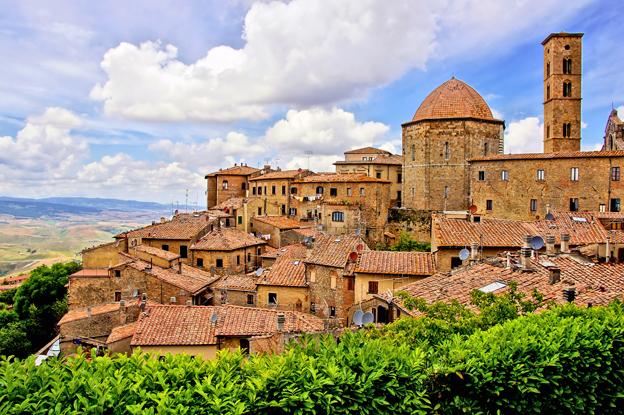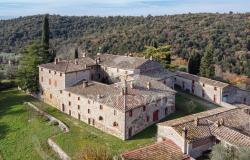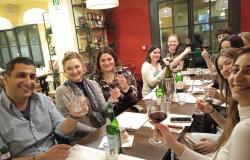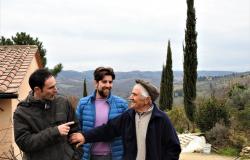Winding roads and a new landscape at every turn, a sense of wonder and anticipation heightens the senses as one reaches the ‘flying city’: Volterra. The name is apt, for at night the city lights, seen from the air, make it look like a massive ship sailing on a sea, a dark sea of hills below. There is only one way in and one way out for a vehicle entering the city. It is enclosed within a wall with stone arches as gates, the roads are narrow and the history glows in this timeless place.
Volterra is somewhat like a womb of history. It has nurtured the original Etruscan settlement as far back as the 8th century BC, when it was called Velathri or Felathri. Under Roman rule, it became a municipium, and later it was occupied by the Florentines, the Medici family and then ruled by the Duchy of Tuscany. Evidence of all is to be found within the walls of Volterra. There are numerous museums, galleries and ancient ruins. At the Teatro Romano, there are ancient Roman baths on a deep slope with an arena and columns that were said to be discovered when a boy kicked a football over the slope and stubbed his toe on what turned out to be the top of one of the columns. It is an incredible excavation in its dimensions, leaving one with a sense of awe at the view of life in Roman times. The Archaeological Park E. Fiumi, an Etruscan site, is still being explored and the Etruscan urns, pots and interesting artefacts lining the walls of the museum remind us of this ancient heritage.

[Photo: The Roman Theater, 1st century BC]
Ancient art and alabaster
Volterra has also been the heart of an industry, the mining of alabaster, since at least the 7th century BC. Its hardness is rated at 2 and 3 on the Mohs scale, alabaster being hydrated calcium sulphate. Alabaster has been used both practically by the Etruscans for their cinerary urns and artistically for alabaster ornaments, lamps, vases, bowls and podiums which are still being made. Today, there are masters of the art of carving and decorating alabaster living and working in Volterra and one can visit their workshops. It is an integral part of Volterra’s history.
Art is prolific here. Painters and creators of art and jewellery reflect the Etruscan designs, the wonderful scenery and religion. This is the town where Rosso Fiorentino’s painting The Deposition of Christ lives, the highlight of an exhibition, "Rosso Vivo", devoted to the Mannerist painter from Florence, currently under way in Volterra. The idea for the exhibition has been conceived by Alberto Bartalini, and it includes works from leading 20th-century artists, on display at each of the prominent venues in Volterra: the Pinacoteca, the Battistero Di San Giovanni, the Museo Etrusco Guarnacci, the Ecomuseo dell’Alabastro, the Palazzo dei Priori, and the Teatro Romano. It is not all beautiful, parts are dark and shocking, a reflection of the events and provocative thoughts surrounding Christ’s death and its darker aspects. It is greatly different from the gushing Palazzo Viti, with its 12 rooms filled with Italian, European and Oriental art. The red geraniums against the stone walls of the bubbling streets and the fantastic views from the heights of the city contrast with the underlying, at times sombre, nature of the past.
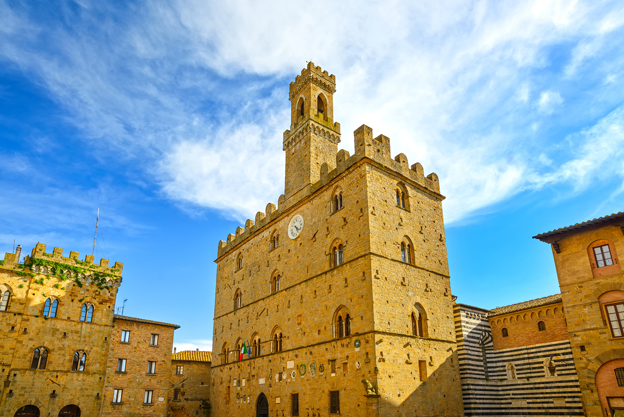
[Photo: Palazzo dei Priori, Volterra]
A natural spring, the views through archways and from terraces fill the senses with a flood of wonder and all the time one is feeling the deep secrets of this fascinating city. The bells still ring from La Cattedrale di Volterra and bats appear at night when the feeling of the unknown creeps in. An ideal setting for filming the Twilight series, where Volterra is home to the Volturi, powerful, ancient vampires. There are tours by moonlight and a visit to the Museo Della Tortura for those who like to venture into such a world.
Right at the top of the city looms a massive fort, Fortezza Medicea, and though one immediately would like to see inside, it is not possible, as it is now used as a state prison which just adds to the bizarre personality of Volterra. No wonder then that religion is also prominent in the city. The patron saint of Volterra is Saint Linus, who was the first pope after Peter the Apostle, and the old convent, which has been there for 400 years, is named San Lino. It has been converted into a beautiful hotel and the view from the terrace right next to the bell tower is magic.

[Photo: Etruscan gate, 4th century BC]
For the tourist
Today’s Volterra has wonderful shopping: alabaster, olive wood, paintings and leather spill out from shop entrances into the ancient streets which are lined with fascinating doorways and shuttered windows, and an aroma that can only be found in Italy. Food and local wines are prepared for the traveller to take away. Restaurants both formal and informal call from the main streets, but they can also be found tucked away in extraordinary places, by following the delicious waft of herbs and spices. The menus are diverse, but in all you will be offered Tuscan cuisine; a must-try is wild boar cooked with olives and served with black fava beans. Because of its relative closeness to Pisa, fresh fish is also part of the local cuisine and there is a pescheria offering many fishy delicacies to take back to your apartment and cook. However, with the variety on offer at the restaurants, it is an easy choice to let the Volterrans do it their style!

The city can captivate the tourist for days and if, at any time, one feels the need to escape the walls, then a few miles drive to San Gimignano, Siena or Cecina on the coast provides more historical delight, more beautiful views, vineyards and horizons with silhouetted cypress trees, so typical of Tuscan landscapes.
Volterra is ancient, yet Volterra nurtures a newer, lighter culture, its past not forgotten nor overlooked, but its future secured by its acknowledgement and preservation of the past. We can wander through and wonder at this incredibly fascinating city which tantalizes us with its secrets and treasures, many of which have yet to be uncovered.
